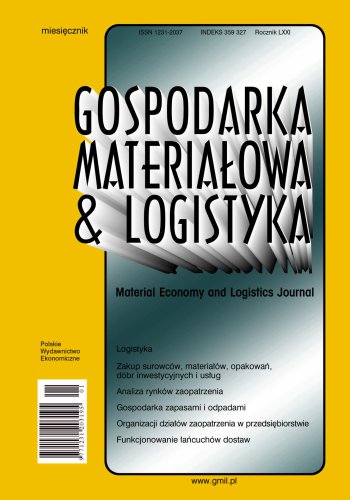The ecological aspect of urban transport in the context of road safety for participants: analysis of road accidents in Poland in 2014–2021
The growing crowding of city centres and the related air and noise pollution cause discomfort for residents. The use of alternative forms of transport should be promoted. The general aim of the article is to show how changing the way of traveling to an ecological one reduces the risk of road accidents while constituting an element of the green transport policy. Theoretical considerations include a literature review and the principles of sustainable development, including green transport. The empirical part examines how the Sustainable Development Goal SDG-13 titled actions in the field of climate protection (such as limiting the use of combustion cars) is related to road safety, which is part of the SDG-3 goal: good health and quality of life. A study of road accidents in Poland confirmed the thesis that the risk of being involved in a traffic accident is lower when traveling by bicycle, motorcycle or on foot compared to driving a passenger car, which may be an argument encouraging employees and residents to change their vehicle from an internal combustion passenger car to a more ecological and at the same time, it will contribute to the implementation of sustainable development goals in the environmental aspect.
References
Bibliografia/References
Aldred, R. (2012). Governing transport from welfare state to hollow state: The case of cycling in the UK. Transport Policy, 23 (September), 95–102. https://doi.org/10.1016/j.tranpol.2012.05.012
Allemann, D., & Raubal, M. (2015). Usage differences between bikes and e-bikes. W: F. Bacao, M. Santos, & M. Painho (Eds.), Agile 2015. Lecture Notes in Geoinformation and Cartography. Springer. https://doi.org/10.1007/978-3-319-16787-9_12
Alvanides, S. (2014). Active transport: Why and where do people (not) walk or cycle? Journal of Transport & Health, 1(4), 211–213. https://doi.org/10.1016/j.jth.2014.11.002
Banister, D. (2008). The sustainable mobility paradigm. Transport Policy, 15(2), 73–80. https://doi.org/10.1016/j.tranpol.2007.10.005
Baseline. (2023). Baseline report on the KPI Helmet use among Cyclists and PTWs. January 2023. https://www.baseline.vias.be/en/publications/kpi-reports/ (dostęp 10.08.2023).
Brand, Ch., Dons, E., Anaya-Boig, E., Avila-Palencia, I., Clark, A., de Nazelle, A., Gascon, M., Gaupp-Berghausen, M., Gerike, R., Götschi, T., Iacorossi, F., Kahlmeier, S., Laeremans, M., Nieuwenhuijsen, M., Orjuela, J. P., Racioppi, F., Raser, E., Rojas-Rueda, D., Standaert, A., Stigell, E., Sulikova, S., Wegener, S., & Panis, L. (2021). The climate change mitigation effects of daily active travel in cities. Transportation Research Part D: Transport and Environment, 93. https://doi.org/10.1016/j.trd.2021.102764
Caglar, A. E., Yavuz, E., Mert, M., et al. (2022). The ecological footprint facing asymmetric natural resources challenges: Evidence from the USA. Environmental Science and Pollution Research, 29. 10521–10534. https://doi.org/10.1007/s11356-021-16406-9
Dai, J., Alvarado, R., Ali, S., et al. (2023). Transport infrastructure, economic growth, and transport CO2 emissions nexus: Does green energy consumption in the transport sector matter? Environmental Science and Pollution Research, 30, 40094–40106. https://doi.org/10.1007/s11356-022-25100-3
Dupuy, G., Fol, S., Coutard, O., Froud, J., & Williams, K. (2002). La pauvreté entre assignation territoriale et dépendance automobile: Comparaison France-Royaume-Uni. Research report. Université de Paris X, Nanterre.
Eurostat. (b.d.). https://ec.europa.eu/eurostat/web/transport/data/database?node_code=tran_sf_road (dostęp 26.07.2023).
Giles-Corti, B., Foster, S., Shilton, T., & Falconer, R. (2010). The co-benefits for health of investing in active transportation. New South Wales Public Health Bulletin, 21, 122–127. https://doi.org/10.1071/NB10027
Godil, D. I., Yu, Z., Sharif, A., Usman, R., & Khan, S. (2021)., Investigate the role of technology innovation and renewable energy in reducing transport sector CO2 emission in China: A path toward sustainable development. Sustainable Development, 29(4), 694–707. https://doi.org/10.1002/sd.2167
GUS. (2015). Badanie pilotażowe zachowań komunikacyjnych ludności w Polsce. Streszczenie raportu końcowego w języku nietechnicznym. https://stat.gov.pl/files/gfx/portalinformacyjny/pl/defaultstronaopisowa/5851/1/1/streszczenie_raportu_badanie_pilotazowe_zachowan_komunikacyjnych.pdf (dostęp 14.08.2023).
Kamel, M., Sayed, T., & Bigazzi, A. (2020). A composite zonal index for biking attractiveness and safety. Accident Analysis & Prevention, 137. https://doi.org/10.1016/j.aap.2020.105439
Khan, S., Zhang, Y., Kumar, A., Zavadskas, E., & Streimikiene, D. (2020). Measuring the impact of renewable energy, public health expenditure, logistics, and environmental performance on sustainable economic growth. Sustainable Development, 28(4), 833–843, https://doi.org/10.1002/sd.2034
Komisja Europejska. (2019). Komunikat Komisji do Parlamentu Europejskiego, Rady Europejskiej, Komitetu Ekonomiczno-Społecznego i Komitetu Regionów. Europejski Zielony Ład. Bruksela.
KRBRD. (2023). Stan bezpieczeństwa ruchu drogowego oraz działania realizowane w tym zakresie w 2022 r. https://www.krbrd.gov.pl/baza-wiedzy/raporty-o-stanie-brd/ (dostęp 10.08.2023).
Ling, Z., Cherry, Ch., Yang, H., & Jones, L. (2015). From e-bike to car: A study on factors influencing motorization of e-bike users across China. Transportation Research Part D: Transport and Environment, 41, 50–63. https://doi.org/10.1016/j.trd.2015.09.012
Nedeliakova, E., & Stasiak-Betlejewska R. (2019). Zarządzanie transportem w polskich miastach w kontekście europejskiej koncepcji zrównoważonego transportu. Transportation Research Procedia, 40, 1150–1157. https://doi.org/10.1016/j.trpro.2019.07.160
Osama, A., & Sayed, T. (2016). Evaluating the impact of bike network indicators on cyclist safety using macro-level collision prediction models. Accident Analysis & Prevention, 97, 28–37. https://doi.org/10.1016/j.aap.2016.08.010
Parlament Europejski, Pernice, D., & Debyser A. (2023). Transport drogowy. Przepisy Ruchu drogowego i bezpieczeństwa. Dokumenty informacyjne o Unii Europejskiej. https://www.europarl.europa.eu/factsheets/pl/sheet/129/transport-drogowy-przepisy-ruchudrogowego-i-bezpieczenstwa (dostęp 10.08.2023).
Policja.pl. (b.d.). Wypadki drogowe w 2021 roku. Raport roczny. www.statystyka.policja.pl (dostęp 17.08.2023).
Pucher, J., & Buehler, R. (2010). Walking and cycling for healthy cities. Built Environment, 36(4), 391–414. https://doi.org/10.2148/benv.36.4.391
Reigner, H., & Brenac, T. (2019). Safe, sustainable… but depoliticized and uneven – A critical view of urban transport policies in France. Transportation Research Part A: Policy and Practice, 121, 218–234. https://doi.org/10.1016/j.tra.2019.01.023
Reisi, M., Sabri, S., Agunbiade, M., Rajabifard, A., Chen, Y., Kalantari, M., Keshtiarast, A., & Li, Y. (2020). Transport sustainability indicators for an enhanced urban analytics data infrastructure. Sustainable Cities and Society, 59. https://doi.org/10.1016/j.scs.2020.102095
Schwanen, T. (2016). Geographies of transport (I): Reinventing a field? Progress in Human Geography, 40(1), 126–137. https://doi.org/10.1177/0309132514565725
Stowarzyszenie Zdrowy Rower. (b.d.). Rowerzyści w Polsce 2021. Raport badawczy. https://www.zdrowy-rower.pl/wpcontent/uploads/2021/05/Raport-bezpiecznie-na-rowerze-2021.pdf (dostęp 10.08.2023).
Ustawa z dnia 20 czerwca 1997 r. – Prawo o ruchu drogowym (Dz.U. z 2022 r., poz. 988, z późn. zm.).

